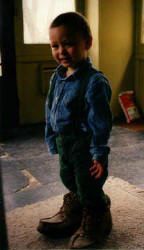 |
Personal Peacemaking
|
VOMP is a method of conflict resolution that I learned as a Resident Assistant
at Georgetown University. Our Area Coordinator, Liz Klafter, taught the staff of
eight Resident Assistants about this process so that when our residents, who
were mostly first-year students, came to us with relationship or roommate
issues, we could facilitate a mediation between the disagreeing parties.
I like teaching about VOMP partly because the name of the process is rather disarming. To say to someone, "We need to VOMP" sounds silly and already adds a sense of levity and humour to a potentially heavy situation.
I also like teaching about VOMP because it is a good process. One of the reasons I believe that people maintain their conflicts and carry them like albatrosses is that we are not comfortable approaching the people we're in conflict with. Through VOMP, we have a process that de-personalizes and de-intensifies the tension between people disagreeing. It becomes less about two people stumbling over words and burdened by hurt feelings and emotions, and more about following a process to clarify the problem and work on resolving the situation.
The first step of VOMP is to Vent. Venting means that each person has an opportunity to tell his/her side of the story uninterrupted, using "I" messages, speaking from first-person point of view. They are able to relate their experience in the conflict while being vigilant not to slander or disrespect their conflict partner. The person listening is practicing active listening skills. Active listening means that each person takes a turn, and while waiting for their turn, they are devoting their entire attention to the words that the other person is saying, rather than trying to formulate immediate responses through interruptions. Each person takes as long as necessary to complete the task of laying out the "facts of the case." Because VOMP is a process, each person knows the steps and is committed to following the steps of conflict resolution.
The second step of VOMP is taking Ownership over the part each person played in the conflict. A conflict is never entirely one-sided. Even in cases where it seems that one person is clearly "in the wrong," both people still have an investment in clarifying the conflict and resolving it, and thus both people can take ownership of their part in the conflict.
| I believe that this is a very exciting step in the process of conflict resolution because it allows each person to assume responsibility for their part in the conflict, and since both people are committed to taking responsibility, much of the fire of hostility is extinguished in this step. We all know what it feels like to be deadlocked in a conflict where each person won't budge, where each person feels he/she stands completely "in the right." No one wants to be the first to "back down" for fear that the other will seize the advantage and take the upper hand in the conflict, dismissing the other as submissive or weak. Ownership is a safe step because both people are committed to this process and to identifying their role in the conflict. Taking ownership of our words and deeds is an important step in the development of human relationships and of personal integrity. |  |
The third step of VOMP is Moccasins. Moccasins means standing in the other person's shoes, seeing the conflict from their perspective. This step elicits empathy from each of the individuals. Empathy is a very important element in learning from our mistakes because it allows us to see the affects our words and actions have on other people and is essential in internalizing the ramifications of what we do and say. When you can see a situation from another person's perspective, you can truly say you have learned an important lesson.
The final step of VOMP is Plan. The parties to the conflict have the opportunity to make a plan of action with respect to their situation so that each person is satisfied and so that a foundation is laid in case a future conflict arises. This plan does not have to be set in concrete and is revisable. As a Resident Assistant in college, some of the "plans" that roommates made ranged from agreeing not to borrow each others' clothes without permission, to ensuring that phone messages were relayed in a timely manner, to setting study time and party time hours for their room and living spaces. Plans are important so that the people involved in the conflict feel like they have accomplished something from their discussion.
Not everyone believes in VOMP, however. In presenting this to my students, I have heard many objections as to why VOMP will not work.
Some students say that is unreasonable to think that people in a conflict will want to follow a process with this ridiculous name, and besides, why would disagreeing people want to talk to each other anyway? In response to this, I agree that angry people probably should not VOMP in the midst of their most heated anger. This process works when both people are committed to resolving the dispute. Students also remind me that not everyone knows about VOMP, which is true. I suggest to them that they introduce the idea of VOMP in a living situation, in a relationship, in a classroom before problems arise so that everyone knows about the process prior to a conflict.
Students also sometimes believe that both people will not be fair in resolving the conflict through VOMP. In this case, they might want to find a neutral third-party to facilitate the VOMP session to ensure that the process is followed in a fair manner.
VOMP is a process. It is not necessarily the right way to resolve conflicts. It is also not the wrong way to resolve conflicts either. VOMP simply provides a framework for people to discuss difficult topics and think sincerely about their roles and their responsibilities as well.
Questions:
Which conflicts in your life might be resolved through VOMP?
What do you think are the strengths of VOMP?
What are its weaknesses?
How young or old do the people using VOMP have to be?
Are there any situations where VOMP would not work?
Could VOMP be applied to international conflicts or should it only be used in interpersonal ones?
© 2002 by Nuclear Age Peace Foundation -
WagingPeace.org
|
|
|||||||
|
home • schools • top 10 actions • about us |
|||||||
copyright © www.worldpeace.org.au 2001-2025
 |
|
 |